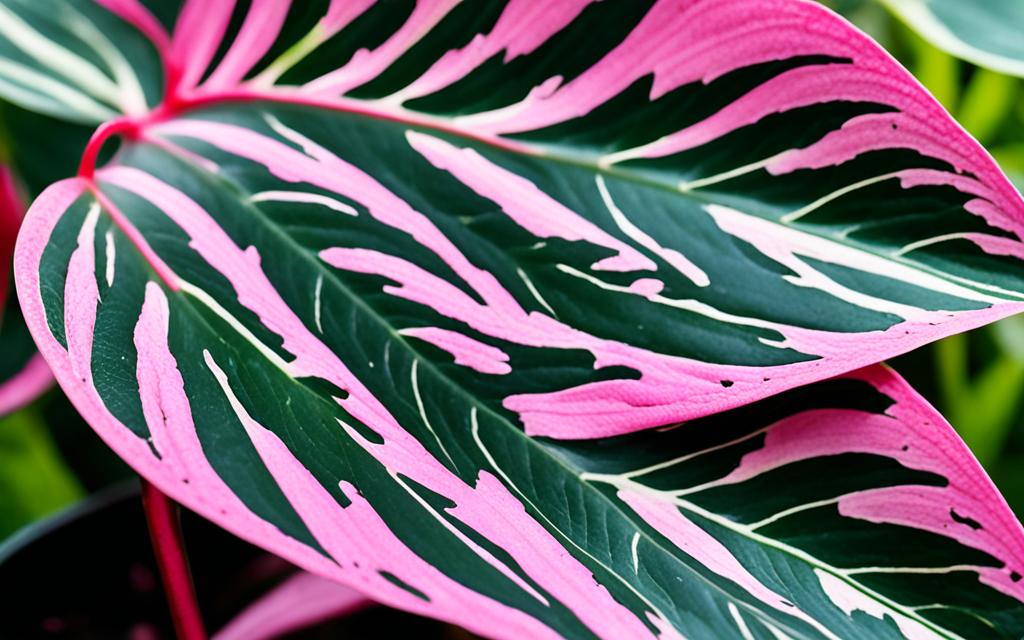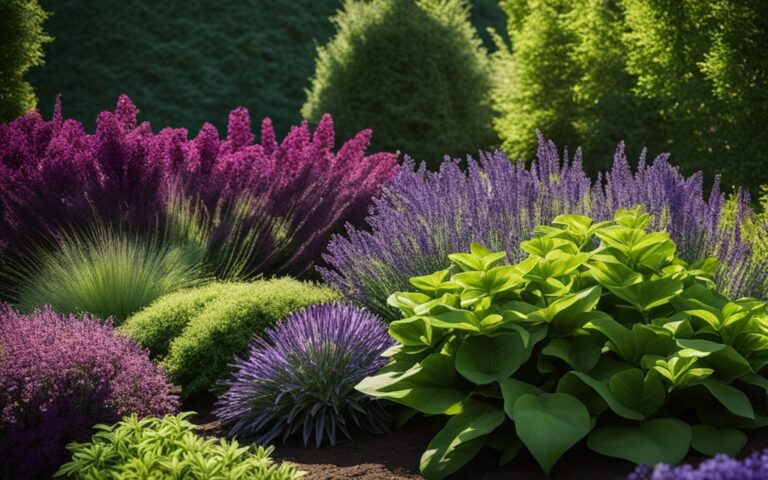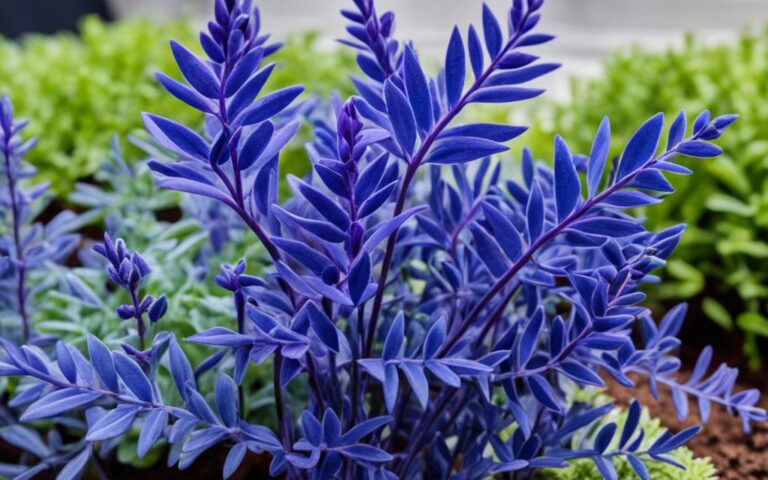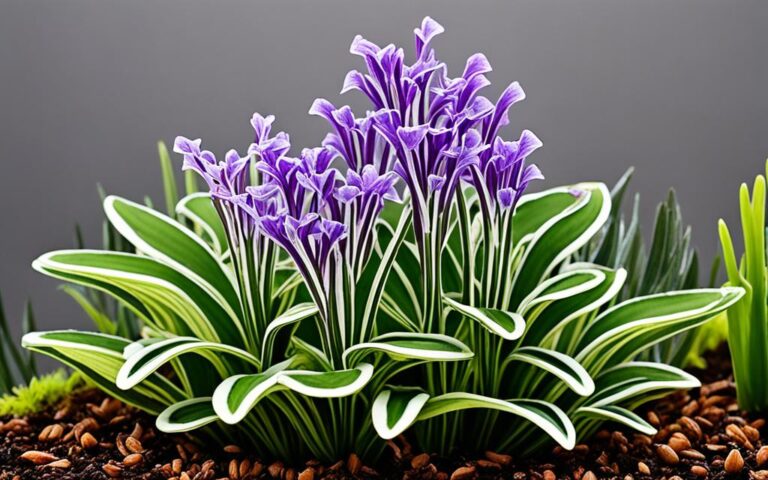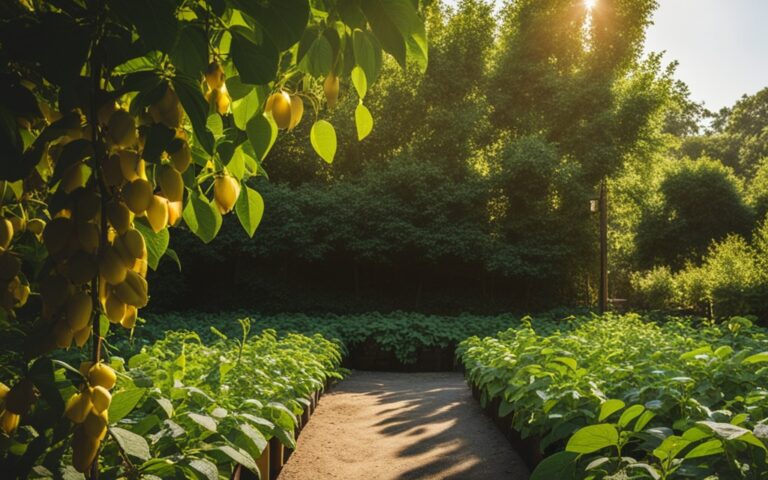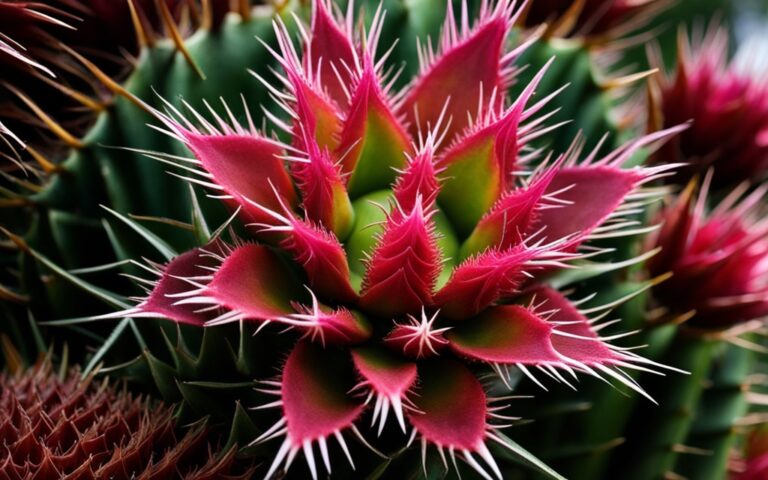Pink Princess Plant: Rare Tropical Beauty for Home
Did you know the Pink Princess Plant, or Philodendron erubescens, is a rare gem? It’s one of the most wanted tropical houseplants globally. Its leaves are a mix of vibrant green and bright pink, making it a standout indoor plant. This plant adds elegance and a touch of the tropics to any room, making it a top choice for homes and gardens.
Key Takeaways
- The Pink Princess Plant is a rare and highly desired tropical houseplant with stunning variegated foliage.
- It is known for its compact, trailing growth habit and can reach up to 4 feet tall and 18 inches wide.
- The plant requires bright, indirect light and average humidity levels of at least 40% to thrive and maintain its vibrant colors.
- Propagating the Pink Princess can be achieved by taking stem cuttings with at least 2-3 leaves and nodes.
- The plant is considered “easy” to care for, making it a great choice for both novice and experienced plant enthusiasts.
Introduction to the Pink Princess Plant
The Philodendron ‘Pink Princess’, or the Pink Princess Plant, is a rare tropical houseplant. It has gained popularity in recent years. This plant is known for its pink and green leaves, making it a favorite among plant lovers.
Its unique look and growing fame have made it a standout in the tropical plant world. The Pink Princess Plant is truly a gem for those who love plants.
Popularity and Rarity
On social media, like Instagram, the Pink Princess Plant has become a hit. Its bright colors and lush leaves have won over many fans. Because it’s hard to find and grow, its cuttings and young plants can be very expensive, sometimes over $100.
This scarcity has made the plant even more sought after. It’s now a top choice for anyone looking to add to their indoor plants.
Interesting Facts About the Pink Princess Philodendron
The Pink Princess Philodendron is a unique plant with many interesting traits. Its pink color comes from a genetic change that lowers chlorophyll production. This makes the plant stand out.
This philodendron can grow quite large, up to 4-5 feet tall and wide. Its heart-shaped leaves and trailing habit add to its beauty. The plant’s size and elegance make it a beautiful addition to any home.
| Plant Type | Perennial |
|---|---|
| Mature Size | 4-5 ft. tall, 2-4 ft. wide |
| Sun Exposure | Partial |
| Soil pH | Acidic |
| Hardiness Zones | 9a, 9b, 10a, 10b, 11a, 11b |
| Cost | Ranging from $30-$60 |
| Past Prices | Fully established plants could cost upwards of $2,000 in 2021 |
| Current Prices | Smaller plants are available for under $100, while cuttings can be purchased for $5 to $10 |
| Price Trends | Prices dropping due to mass production |
The Pink Princess Plant is a favorite among plant lovers. Its bright colors, size, and beauty have won over many hearts. It’s a beautiful addition to any indoor garden.
Varieties and Species of Pink Princess Plant
The Pink Princess Plant is a stunning type of Philodendron erubescens, part of the Araceae family. It’s the most popular variety, but there are others like “Pink Congo” and “Pink Princessa.” They all belong to the Philodendron erubescens species. These plants have different levels of pink color and growth patterns.
Knowing about the pink princess philodendron varieties and philodendron erubescens species helps gardeners choose and care for these plants. It also shows the variety within this interesting plant group.
| Variety | Description |
|---|---|
| Pink Princess | The most popular and well-known cultivar, featuring striking pink and green variegation on the leaves. |
| Pink Congo | A Philodendron erubescens cultivar with a more compact growth habit and a slightly different pink variegation pattern. |
| Pink Princessa | Another Philodendron erubescens cultivar that shares similarities with the Pink Princess but may exhibit a more vibrant or hues of pink. |
Looking into these pink princess philodendron varieties and philodendron erubescens species opens up new possibilities. It lets plant lovers add tropical beauty to their spaces indoors or outdoors.
Anatomy and Features of the pink princess plant
The pink princess plant is famous for its beautiful pink princess plant leaves and lively colors. Its heart-shaped leaves can grow up to 9 by 5 inches. They mix lush green with bright pink, creating a stunning look. The philodendron erubescens stems are green and can trail or climb, based on how the plant grows and its support.
The plant anatomy of pink princess focuses on its amazing leaves. But, its pink princess plant flowers are worth noting too. In spring and summer, it produces small, not-so-visible philodendron erubescens blooms that are green and white. These flowers match the leaves well. The unique features of pink princess also include aerial roots. These roots help the plant climb and can be used to make new plants.
| Feature | Description |
|---|---|
| Leaves | Heart-shaped, glossy, and leathery texture, up to 9 by 5 inches in size, featuring vibrant green and pink variegation |
| Stems | Typically green, can be trailing or climbing depending on growth habit and support |
| Flowers | Small, inconspicuous, green and white in color, produced during spring and summer |
| Aerial Roots | Can be used to support climbing growth and for propagation |
The pink princess plant is a beautiful tropical plant. It wows with its eye-catching leaves and special features. It’s a favorite among plant lovers.
Ideal Growing Conditions for Pink Princess Plant
The Pink Princess Philodendron has unique needs to thrive. It needs specific conditions to grow well and show off its vibrant colors. Here are the key things it needs to grow perfectly.
Light Requirements
This plant loves bright, indirect light. It needs sunlight to keep its pink variegation looking great. Direct sunlight can fade the pink parts, so it’s best in an east- or west-facing window.
Make sure it gets several hours of indirect sunlight each day. Avoid direct sunlight to prevent leaves from fading or getting brown spots.
Temperature and Humidity Needs
The Pink Princess Philodendron likes warm temperatures and high humidity. It does best in a spot with temperatures between 65°F and 85°F (18°C to 29°C). Keep it away from temperatures below 60°F (15°C) to prevent damage.
It also needs a humid environment, with a humidity of 50% or more. The right temperature and humidity help it grow well and stay colorful.
Soil and pH Preferences
This plant prefers soil that drains well and is rich in nutrients. A mix made for tropical plants or a blend of peat moss, perlite, and composted bark works great. The soil should be slightly acidic, with a pH between 5.5 and 6.5.
Good drainage is key to prevent root rot, which can harm the plant. Make sure the soil is well-aerated and drains well.
Propagating the Pink Princess Plant
The Pink Princess Philodendron is a rare and stunning tropical plant. You can easily propagate it at home. This is a great way to grow more plants or share them with friends.
The best time to take cuttings is in the spring or early summer. Choose a healthy stem with 2-3 nodes. Cut just below the lowest node. Let the cutting dry and callus for 12-24 hours before planting.
You can root the cutting in water or a well-draining potting mix. In water, submerge the bottom node and wait for 2-3 weeks. Or, plant it in a mix of half soil and half perlite. Keep the soil moist but not too wet.
Provide the cutting with plenty of indirect sunlight, about 6-8 hours a day. Keep humidity around 50% or higher. The ideal temperature is between 60-85°F (16-29°C).
After 2-3 weeks, the cutting should have strong roots. You can then move it to its own pot. Look for new leaf growth in 4-6 weeks, which means it’s doing well. Feed the young plant with a balanced fertilizer during the growing season.
Propagating the Pink Princess Philodendron is rewarding. It lets you share this rare and beautiful plant with others. With the right techniques and conditions, you can grow your collection or give thoughtful gifts to plant lovers.
“Propagation is an excellent way to expand your Pink Princess collection and share this rare and beautiful plant with others.”
Care and Maintenance Tips
To keep the Pink Princess Philodendron looking great, you need to pay attention to its care. This includes watering, fertilizing, pruning, and training. Follow these tips to help your plant grow well at home.
Watering and Fertilizing
Keep the soil of the Pink Princess Philodendron moist but not soaked. Check the soil and water when it feels dry about an inch down. Feed the plant with a balanced fertilizer every 2-3 weeks when it’s growing. Cut back on fertilizing in the fall and winter to prevent too much growth.
Pruning and Training
This plant is easy to care for but might need some pruning and training. Prune in spring or fall to get rid of dead or damaged leaves. This encourages new, healthy leaves to grow. Training, like tying the stem to a support, helps it grow neatly.
| Care Aspect | Recommended Practices |
|---|---|
| Watering | Water when the top inch of soil dries out, avoiding complete dryness |
| Fertilizing | Use a balanced, water-soluble fertilizer every 2-3 weeks during the growing season, reduce frequency in fall and winter |
| Pruning | Remove dead, damaged, or discolored leaves in spring or fall to encourage new growth |
| Training | Tie the main stem to a support structure to promote a compact, well-shaped appearance |
By following these tips, your Pink Princess Philodendron will stay healthy and beautiful. It will be a lovely part of your indoor garden.
“Proper care and maintenance will help ensure the Pink Princess Philodendron thrives and maintains its stunning coloration.”
Common Pests and Diseases
The Pink Princess Philodendron is a beautiful houseplant with pink and green leaves. But, it can face pests and diseases if not cared for right. Knowing how to handle these issues is crucial for keeping your plant healthy and looking great.
Spider mites are a big problem for Pink Princess plants. These tiny bugs can make leaves turn yellow or bronze and leave fine webs. To fight spider mites, you can use a mix of alcohol and water or stronger chemicals like Oberon Insecticide. Keeping the plant moist and clean helps prevent these pests.
Scale insects are another pest to watch out for. They look like tiny domes or bumps on the plant and leave sticky stuff behind. To get rid of them, you can use alcohol-soaked cotton swabs, insecticidal soaps, or neem oil. Keep an eye on your plant and deal with ants to stop scale from spreading.
- Fungus gnats and fruit flies can be a bother, but you can fight them by keeping the soil dry, using sticky traps, and applying chemicals like isopropyl alcohol or insecticide sprays.
- Mealybugs look like cotton and live in leaf joints and near the soil. They need quick action with manual removal and insecticidal soaps.
- Aphids can be washed off with water, sprayed with alcohol, or encouraged to leave with ladybugs.
- Thrips can be controlled by pruning, washing with soapy water, using systemic insecticides, and sticky traps.
Pink Princess Philodendron can also get fungal diseases like root rot and rust spots if it’s overwatered or too humid. Keep an eye on your plant and treat with fungicides quickly to stop these diseases.
Using an Integrated Pest Management (IPM) approach helps gardeners deal with pests and diseases. This method combines different ways to keep pests away, ensuring your Pink Princess plant stays healthy and beautiful.
Benefits of Growing a Pink Princess Plant
The Pink Princess Philodendron is a tropical gem that offers more than just stunning visuals. It can make indoor spaces better and give many benefits to those who care for it.
One big plus of having a pink princess plant is it cleans the air. Like other philodendrons, it takes in bad toxins and gives out oxygen. This makes the air cleaner and healthier to breathe.
The pink princess plant grows well in small spaces because it’s compact and trails. Its bright, patterned leaves can make any room look more elegant and tropical. This brings a feeling of calm and relaxation to your home.
“The benefits of having a pink princess plant go beyond its looks. Studies show that plants can make us feel better, lifting our mood and cutting down stress.”
Also, the pink princess philodendron is rare and sought after by plant lovers. Its unique look and special qualities have made it a top choice for houseplants. This adds a special touch to any garden.
The benefits of growing a pink princess plant are many. It’s not just about how pretty it is. It also cleans the air, brings calm, and is a collector’s dream. This tropical beauty is a great addition to any home, blending beauty with practicality.
Where to Buy pink princess plant
Finding the Pink Princess Philodendron is tough for plant lovers. This plant is rare and very wanted. You won’t find it at regular garden centers or big stores. To get your hands on Pink Princess plant, check out specialty nurseries, online sites, and individual sellers.
Online spots like Etsy and Facebook Marketplace are great for where to purchase pink princess plant. Make sure to pick a seller who offers healthy, real plants to avoid being let down. Some trusted online shops also have the Pink Princess Philodendron, but they often run out fast.
Since the Philodendron Pink Princess is so rare, you need to be quick when you see it for sale. Being patient and keeping an eye out is important to find this plant for your home.
| Key Facts About Buying Pink Princess Plants |
|---|
| – The Pink Princess Philodendron is sold in 4″ nursery pots unless otherwise specified. |
| – Prices for a Pink Princess plant typically range from $100 to $300 due to its rarity and exclusivity. |
| – Online plant retailers have reported a 150% increase in Pink Princess sales over the past year. |
| – Propagation success rate for the Pink Princess is around 70% through stem cuttings. |
With patience, persistence, and a keen eye, plant lovers can bring the beautiful Pink Princess Philodendron into their homes. This plant’s unique beauty and rarity make it a special addition.
Handling and Preventing Issues
The Pink Princess Philodendron is a beautiful houseplant, but it can have problems. Knowing the common issues and how to prevent them helps your plant stay healthy and colorful.
Resolving Legginess and Lack of Color
Leggy growth and loss of vibrant color are common problems. This happens when the plant doesn’t get enough light. It stretches to find more sunlight, making it look spindly.
To fix this, move your Pink Princess to a spot with more indirect sunlight. It needs bright, indirect light to keep its pink and green colors looking great.
Treating Pest Infestations
Pests like aphids, spider mites, mealybugs, and scale insects can harm the Pink Princess. They can make leaves and stems look bad, stop growth, and make the plant decline. To deal with pests, figure out what they are and use things like insecticidal soaps or neem oil sprays.
Keeping your plant clean by checking it often and removing bad leaves helps prevent pests. This way, your Pink Princess Philodendron will stay healthy and beautiful.
Fixing problems like legginess, color loss, and pests keeps your Pink Princess Philodendron looking great. With the right care, this rare plant will keep amazing everyone who sees it.
Pink Princess Plant in Social Media
The Pink Princess Philodendron has become a hit on social media, especially on Instagram. People love sharing pictures of this beautiful plant. Its pink and green leaves have caught the eye of many indoor gardeners and collectors.
This has made the plant very popular and more valuable. Houseplant sales have jumped by 50% in the last three years, reaching a billion dollars. Many of these sales happen online. The demand for rare plants has led to more fake plants being sold on eBay and Amazon.
But the love for the pink princess philodendron on social media is real. Growers like Gabriella Growers had over 5,500 people waiting to buy the plant at one time.
Thanks to social media, the pink princess plant trends have made it a top choice for houseplants. It’s now a rare and expensive plant for plant lovers. Before, a piece of the Pink Princess plant cost more than $100. Now, its popularity online has made growing it profitable but challenging for growers.
| Statistic | Value |
|---|---|
| Increase in Houseplant Sales | 50% over the past 3 years |
| Houseplant Industry Value | $1 billion |
| Waiting List for Pink Princess Philodendron | Over 5,500 at one point |
| Price for Pink Princess Plant Cutting | Upwards of $100 |
| Maximum Height of Pink Princess Plant | 4 feet |
The unique look of the Pink Princess plant has sparked huge interest. Growers are now creating new types with different patterns and colors. But, some plants sold as Pink Princess aren’t really the real thing. They’re sold at high prices.
The buzz around the pink princess philodendron on social media has also brought attention to other pink Philodendrons. The Pink Congo is one, known for its pink leaves that turn green over time.
In conclusion, the pink princess plant has become a star on social media. It has won over plant lovers and increased demand. The response from the industry is both exciting and cautious. Growers are working hard to meet demand while fighting against plant fraud.
Conclusion
The Pink Princess Philodendron is a standout among tropical plants, loved by indoor gardeners and plant lovers across the U.S. Its pink and green leaves, compact size, and easy care make it a great choice for any home.
This plant’s rarity and growing popularity mean it’s a bit pricey. Yet, the happiness and pride of growing a Pink Princess Philodendron make it worth it. With the right care, gardeners can enjoy its beauty and benefits for many years.
In summary, the summary of pink princess plant, final thoughts on philodendron erubescens, and key takeaways about pink princess highlight its value for indoor gardening fans. Its striking look, easy care, and potential for growth make the Pink Princess Philodendron a top choice in tropical houseplants.
